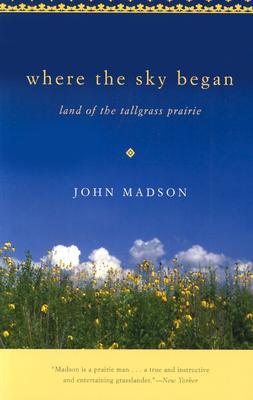 I found a little gem of a book the other day about the tallgrass prairie called Where the Sky Began by John Madson. It’s a highly informative book detailing much of the natural history of the tallgrass prairie all the way from the reasons that prairies exist on the continent:
I found a little gem of a book the other day about the tallgrass prairie called Where the Sky Began by John Madson. It’s a highly informative book detailing much of the natural history of the tallgrass prairie all the way from the reasons that prairies exist on the continent:
“Our northern grasslands took shape during the most recent ticks of th geological clock, under the great glacial advances of the Pleistocene.”
to the early sightings of Europeans:
“The scenery of the prairie is striking and never fails to cause and exclamation of surprise. The extent of the prospect is exhilarating. The outline of the landscape is sloping and graceful. The verdue and the flowers are beautiful; the absence of shade, and consequent appearance of profusion of light, produce a gaiety which animates the beholder.” – Judge James Hall, 1839
to an extensive treatment of the flora:
“From the first greening of spring to the full ripening of autumn, (the prairie) is spangled by a vivid progression of flowers – a rainbow host that first enamels the burned slopes of early spring and ends months later with great nodding blooms that rise above a man’s head.”
as well as the fauna:
“The tallgrass prairie was a great faunal crossroads – the eastern limit of some wildlife species, the western limit of others. The great edge effect was exerted where tallgrass prairie and forest met, and its carrying capacity for many types of wildlife was immense.”
He also discusses the famous changeable weather of the prairie:
“The continental weather that sweeps the tallgrass prairie is a raw, unrefined climate, untempered by any large bodies of water that might serve as resevoirs of warmth in winter and collness in summer. Frostbite one month, sunstroke the next. Some prairie years have a temperature range of nearly 150 degrees.”
Madson’s knowledge of the prairie is surpassed only by his love of the prairie, and his best writing springs from this pure affection:
My feeling for tallgrass prairie is like that of a modern man who has fallen in love with the face in a faded tintype. Only the frame is still real; the rest is illusion and dream. So it is with the original prairie. The beautiful face of it had faded before I was born, before I had a chance to touch and feel it, and all that I have known of the prairie is the setting and the mood—a broad sky of pure and intense light, with a sort of loftiness to the days, and the young prairie-born winds running past me from open horizons.

